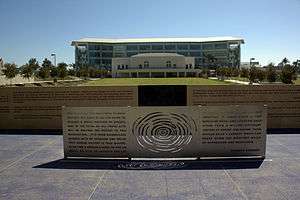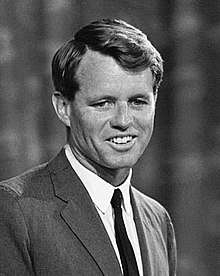Ambassador Hotel (Los Angeles)
| Ambassador Hotel | |
|---|---|
 Ambassador Hotel, 2004. | |
 Ambassador Hotel Location within the Los Angeles metropolitan area  Ambassador Hotel Ambassador Hotel (California)  Ambassador Hotel Ambassador Hotel (the US) | |
| General information | |
| Location |
3400 Wilshire Boulevard Los Angeles, California United States |
| Coordinates | 34°03′35″N 118°17′50″W / 34.059646°N 118.297101°WCoordinates: 34°03′35″N 118°17′50″W / 34.059646°N 118.297101°W |
| Opening | 1921 |
| Closed | 1989 |
| Design and construction | |
| Architect | Myron Hunt |
| Other information | |
| Number of rooms | 500 |
The Ambassador Hotel was a hotel in Los Angeles, California, and location of the Cocoanut Grove nightclub until it was demolished in 2005. The hotel began operation formally on January 1, 1921. It was the site of the Academy Awards six times (the 2nd, 3rd, 5th, 6th, 12th, and 15th) and the June 1968 assassination of presidential candidate Robert F. Kennedy. The hotel closed to guests in 1989.
Background
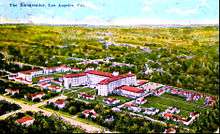
The Ambassador Hotel was located at 3400 Wilshire Boulevard, between Catalina Street and Mariposa Avenue in what is now known as Koreatown. It was designed by Pasadena architect Myron Hunt in an eclectic Mediterranean Revival style with Art Deco elements and signage.
The Ambassador Hotel was frequented by celebrities, some of whom, such as Pola Negri,[1] resided there. From 1930 to 1943, six Academy Awards ceremonies were performed at the hotel. Perhaps as many as seven U.S. presidents stayed at the Ambassador, from Hoover to Nixon, along with chiefs of state from around the world. For decades, the hotel's famed Cocoanut Grove nightclub hosted well-known entertainers, such as Frank Sinatra, Barbra Streisand, Judy Garland, Lena Horne, Nancy Wilson, Bing Crosby, Nat King Cole, Liza Minnelli, Martin and Lewis, The Supremes, Merv Griffin, Dorothy Dandridge, Vikki Carr, Evelyn Knight, Vivian Vance, Dick Haymes, Sergio Franchi, Perry Como, Dizzy Gillespie, Benny Goodman, Sammy Davis Jr., Little Richard, Liberace, Natalie Cole, Richard Pryor and Shirley Bassey.
1920s
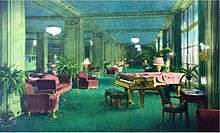
During the 1920s, the Ambassador Hotel's nightclub Cocoanut Grove was frequented by celebrities like Louis B. Mayer, Charlie Chaplin, Douglas Fairbanks and Mary Pickford, Howard Hughes, Clara Bow, Rudolph Valentino, Gloria Swanson, Anna May Wong, Norma Talmadge and others. According to Photoplay, Joan Crawford and Carole Lombard were frequent competitors in the Charleston contests held on Friday nights; Lombard was discovered at the Grove.[2]
Starting in 1928, Gus Arnheim led the Cocoanut Grove Orchestra. Six to seven songs were sung each night. There was a two-hour broadcast of the orchestra on the radio.[3]
The names of the hotel and its nightclub quickly became synonymous with glamour; "Cocoanut Grove" would become a trendy name for bars and clubs across the United States.
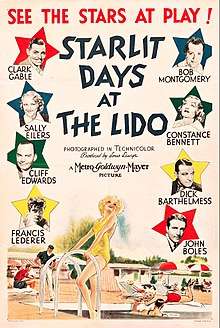
1930s
During the 1930s the Cocoanut Grove was frequented by celebrities of cinema such as Norma Shearer and Irving Thalberg, Errol Flynn, Jean Harlow, Clark Gable and Carole Lombard, Katharine Hepburn, Spencer Tracy, Cary Grant, Jimmy Stewart, Marlene Dietrich, Lana Turner, John Wayne, Henry Fonda, Lucille Ball, Ginger Rogers, Gary Cooper, Loretta Young, and countless others. On February 29, 1940, the 1939 Academy Awards Ceremony was held in the Cocoanut Grove, with Bob Hope hosting.[4]
Loyce Whiteman, singer for the Cocoanut Grove Orchestra, recalled, "the most beautiful thing about the Grove is that they stood in front of you when you sang and just swayed to the music. Joan Crawford would stand at the stand and sing a couple of choruses with the band. It was a house full of stars."[3]
An early MGM color movie short, Starlit Days at the Lido (1935), was filmed at the Lido Spa in the Ambassador, of a lunchtime tea dance featuring the Henry Busse band and vocalists, novelty acts with Arthur Lake), Cliff Edwards and Ben Turpin, chorus girls and reaction shots of "guests," including Francis Lederer, Buster Crabbe, John Boles and MC Reginald Denny.
1940s
During World War II the Ambassador Hotel was used for war fundraisers in Cocoanut Grove and when the war ended, the Cocoanut Grove became a retreat for servicemen, servicewomen, and many movie actors.
Ambassador Hotels System
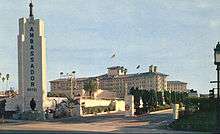
The Ambassador Los Angeles was built as part of the Ambassador Hotels System. At the time the hotel opened in January 1921, the chain consisted of the Ambassador Los Angeles, the Hotel Alexandria in Los Angeles, the Ambassador Santa Barbara, the Ambassador Atlantic City and the Ambassador New York. The Santa Barbara property burned down soon after on April 13, 1921, and the Alexandria left the chain in 1925, while the Ambassador Palm Beach joined in 1929.
The chain was eventually dissolved in the 1930s. The Ambassador Los Angeles was sold to Schine Hotels. The Ambassador New York was sold and operated independently until 1958, when it was sold to Sheraton Hotels and renamed the Sheraton-East. It was demolished in 1966 for the construction of 345 Park Avenue. The Ambassador Atlantic City was gutted in the late 1970s and converted to the Tropicana Casino & Resort. The Ambassador Palm Beach was sold in 1933 and became the Palm Beach Biltmore, before being converted to condos.
Robert F. Kennedy assassination
In the pantry area of the hotel's main kitchen, soon after midnight on June 5, 1968, and after a brief victory speech in the Embassy Room ballroom of the Ambassador Hotel, the winner of the California Democratic presidential primary election, Senator Robert F. Kennedy, was shot along with five other people. Palestinian immigrant Sirhan Sirhan was arrested at the scene and later convicted of the murder. Kennedy died one day later from his injuries, while the other victims survived their wounds. During the demolition of the Ambassador Hotel in late 2005 and early 2006, portions of the area where the 1968 shooting occurred were eliminated from the site. The section of Wilshire Boulevard in front of the hotel has been signed the "Robert F. Kennedy Parkway".[5]
Decline and closure
The death of Robert F. Kennedy coincided with the beginning of the hotel's demise, hastened by the decline of the surrounding neighborhood. By the 1970s, the gang and illegal drug problems in the area near the hotel were already becoming severe, and worsened. Despite a renovation of the Cocoanut Grove in the mid-1970s, with the creative control of Sammy Davis, Jr., the property declined.
The Ambassador Hotel was closed in 1989 to guests, but remained open for filming and private events. A liquidation sale of the hotel's contents was conducted in 1991.
Donald Trump proposed in 1989 to build a 125-story building, the world's largest, and entered a protracted legal fight with the Los Angeles Unified School District, which eventually won and developed a school in this district of Wilshire boulevard. Many were surprised that such a historic building did not receive the status to be historically preserved despite being host to every U.S. President from Dwight Eisenhower to Richard M. Nixon.
Filming/photography at the hotel
The hotel was a popular filming location and backdrop for movies and television programs, starting with Jean Harlow's 1933 film Bombshell. As business declined and was eventually shuttered, it provided a convenient filming location for hotels and restaurants in The Graduate, Beverly Hills, 90210, L.A. Story, Pretty Woman, True Romance, The Wedding Singer and many other films and television shows. A living time capsule of the period, it was a perfect location to represent any 1950s through 1970s period hotels, as in Almost Famous, Apollo 13, Catch Me If You Can, Hoffa, and That Thing You Do.[6]
The last project to specifically film in the infamous kitchen was "Spin the Bottle", a 2004 episode of the TV series Angel.[7] The 2006 film Bobby was the last project to physically film on the hotel property, gaining access in late 2005 to film crucial establishing shots even while portions of the hotel were already in the process of being demolished.[8]
Following its closure, the Los Angeles Police Department used the property to train for large scale operations requiring the coordination of many officers. The 2003 film SWAT recreated such training, in scenes shot at the hotel.
The Ambassador itself has been memorialized as a "character" in films. The Cocoanut Grove was recreated for the 2004 movie The Aviator, while the 1999 film The Thirteenth Floor recreates the hotel when the main characters visit 1937 Los Angeles.
The Cocoanut Grove also hosted musician Roy Orbison and several performers in September 1987 for the television special Roy Orbison and Friends: A Black and White Night, first shown on Cinemax in early 1988. Rock band Linkin Park also held their press photo shoot for their 2003 album Meteora at the hotel. Guns N' Roses filmed the music video for their song, "Patience", in the hotel in 1989. R&B singer "Chuckii Booker" filmed the music video for his song "Games" from the album Niice 'n Wiild at the hotel in 1992.
Preserve or demolish?
From 2004 to 2005, the Ambassador Hotel was closed completely and became the topic of a legal struggle between the Los Angeles Unified School District (LAUSD), which wanted to clear the site and build a school; Sirhan Sirhan, who, through his lawyer the late Lawrence Teeter, wanted to conduct more testing in the pantry where Robert F. Kennedy was shot; and the Los Angeles Conservancy and Art Deco Society preservationists, who wanted the hotel and its various elements saved and integrated into the future school.
The Location Managers Guild organized an event together with the Jefferson High School Academy of Film and Television in March 2005, entitled Last Looks: The Ambassador Hotel. They mentored students in script breakdown and location scouting, using the hotel as a potential location to be scouted, documenting the property one last time. The images taken by both the students and the professionals were then exhibited side by side at Los Angeles City Hall.[9]
After much litigation, a settlement was attained at the end of August 2005, allowing the demolition to begin in exchange for the establishment of a $4.9 million fund, reserved for saving historic school buildings in the Los Angeles Unified School District.
Demolition
On September 10, 2005, a final public auction was held for the remaining hotel fittings and work soon began on demolition of the Ambassador Hotel. On January 16, 2006, the last section of the Ambassador fell, with most of the demolition being done during 2005, leaving only the annex that housed the hotel entrance, a shopping arcade, the coffee shop, and the Cocoanut Grove, all of which were promised to be preserved in some manner and used in the new school.
A wake attended by hundreds of people was held for the Ambassador Hotel on February 2, 2006 at the Gaylord Apartments and adjoining restaurant H.M.S. Bounty, both part of a historic building built during 1924, directly across the street from the Ambassador Hotel; Diane Keaton, who was one of many who fought for the preservation of the hotel, was among the speakers of the ceremony.[10]
Cocoanut Grove preservation
The Cocoanut Grove was renovated several times before, destroying much of its architectural integrity, and it was promised that it would undergo yet another major transformation before becoming the auditorium for the new school. Also promised was preservation of the attached ground floor coffee shop, designed by noted architect Paul Williams.
Due to claims of poor structural integrity, however, the LAUSD decided to demolish most of the Cocoanut Grove, retaining only the hotel entrance and east wall of the Grove.
2006–2010
The Central Los Angeles New Learning Center #1 K–3,[11] and Central Los Angeles New Learning Center #1 4–8/HS, along with the Robert F. Kennedy Inspiration Park, were built on the site.[12]
The six schools were named as the Robert F. Kennedy Community Schools. The K–3 facility opened on September 9, 2009 and the 4–8 and high school facility began operation on September 14, 2010. The north side of the new school has a slightly similar appearance to the original facade of the hotel and north lawns will remain much the same, as seen from Wilshire Boulevard.
Documentary
A feature-length documentary film by Camilo Silva, After 68: The Rise and Fall of the Ambassador Hotel, is being made with an estimated release date in 2014. In a 2013 interview Silva reported that the film was "about half" shot.[13]
See also
References
- ↑ Alleman, Richard (6 March 2013). Hollywood: The Movie Lover's Guide: The Ultimate Insider Tour of Movie L.A. Crown Publishing Group. p. 139. ISBN 978-0-8041-3777-5.
- ↑ Knowles, Mark (2009). The Wicked Waltz and Other Scandalous Dances: Outrage at Couple Dancing in the 19th and Early 20th Centuries. McFarland. p. 233. ISBN 978-0-7864-5360-3.
- 1 2 "Six Big Band singers reminisce". YouTube. YouTube, LLC. December 21, 2013. Retrieved January 26, 2016.
- ↑ Faith, William Robert (24 April 2009). Bob Hope: A Life in Comedy. Da Capo Press. p. 145. ISBN 978-0-7867-2902-9.
- ↑ Harris, Erin Mahoney (November 2010). Walking L.A.: 38 Walking Tours Exploring Stairways, Streets and Buildings You Never Knew Existed. ReadHowYouWant.com. p. 197. ISBN 978-1-4596-0809-2.
- ↑ Nichols, Chris. "MoviesFilmed at the Ambassador Hotel". Los Angeles Magazine. Retrieved 25 September 2016.
- ↑ Commentary. Episode "Spin the Bottle". Angel, Season 4 DVD set.
- ↑ Levy, Emanuel. "Ambassador Hotel and Bobby: Robert Kennedy's Assassination". Emanuel Levy Cinema 24/7. Retrieved 25 September 2016.
- ↑ Reynolds, Christopher (December 16, 2005). "Remains of the day". Los Angeles Times. Retrieved 25 September 2016.
- ↑ Meares, Hadley (June 21, 2013). "The Gaylord Apartments: Luxury, Socialism, and L.A.'s First Failed Co-op". Departures. KCET. Retrieved 19 March 2016.
- ↑ Facilities Services Division (26 February 2010). "Project Details: Central LA New Learning Center #1 K-3, 55.98046A". Los Angeles Unified School District. Retrieved 17 September 2010.
- ↑ Facilities Services Division (26 February 2010). "Project Details: Central LA New Learning Center #1 MS/HS, 55.98046". Los Angeles Unified School District. Archived from the original on 27 August 2010. Retrieved 17 September 2010.
- ↑ Danaparmita, Aria. "[Interview] Camilo Silva, Filmmaker: After 68 Stars the Ambassador Hotel -- and Preservation". National Register of Historic Places. Retrieved 24 June 2018.
Further reading
Mathison, Dirk (June 1998). "Heartbreak Hotel". Los Angeles Magazine. Emmis Communications: 77–85, 134. ISSN 1522-9149.
External links
| Wikimedia Commons has media related to Ambassador Hotel (Los Angeles). |
- TheAmbassadorHotel.com
- The Ambassador's Last Stand
- The Ambassador Hotel at Seeing Stars: the Ultimate Guide to Celebrities & Hollywood website
- Gallery of 135 photos taken between 2003 through 2005
- In Memoriam: Art "The Doorman" Nyhagen, a tribute to the long-time doorman at The Ambassador, with vintage photos
- "L.A. Unified's faulty vision for schools on Ambassador site", Christopher Hawthorne, Los Angeles Times, July 18, 2010
